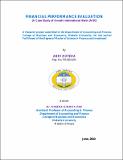| dc.description.abstract | This study was conducted under the title “Financial performance evaluation: a case study of
Awash International Bank (AIB) S.C.”. Its main objective was to compare and examine
empirically the performance of the first private commercial bank in Ethiopia, i.e. Awash
International Bank (AIB) in comparison with industry average with respect to liquidity;
profitability; credit risk & solvency and efficiency for the period of 2003-2009.
This study was employing ratios (15 in total) such as Return on Asset (ROA), Return on Equity
(ROE), Profit Expense Ratio (PER), Return On Deposit (ROD), Net Interest Margin (NIM),
Loan to Deposit ratio (LDR), Cash To Deposit Ratio (CDR) Loan to Assets Ratio (LAR), Debt to
Equity Ratio (DER), Debt to Total Asset Ratio (DTAR); Equity Multiplier(EM), Nonperforming
Loans to Total Loans, Asset Utilization (AU), Income to Expense ratio (IER) and
Operating Efficiency(OE).
This study found that all results of profitability measures go in favor of industry average. The
results indicate that Awash International Bank was less profitable than industry average.
However, AIB was consistently improving and performing better in making good returns on
investment (assets), satisfying their shareholders in offering competitive or even better returns,
making good returns customers’ deposits and also managing their operating expenses over the
Years until 2007.From 2007 onwards, profitability of the bank started to decrease. Besides, an
overall analysis of all liquidity, efficiency, and risk and solvency measures reveals that AIB was
less liquid, efficient in asset utilization, income generation, and managing its expenses and less
risky and more solvent than industry average. However, the results also show the AIB is
improving overtime considerably in these liquidity, efficiency and risk & solvency measures
during the period under the study | en_GB |


